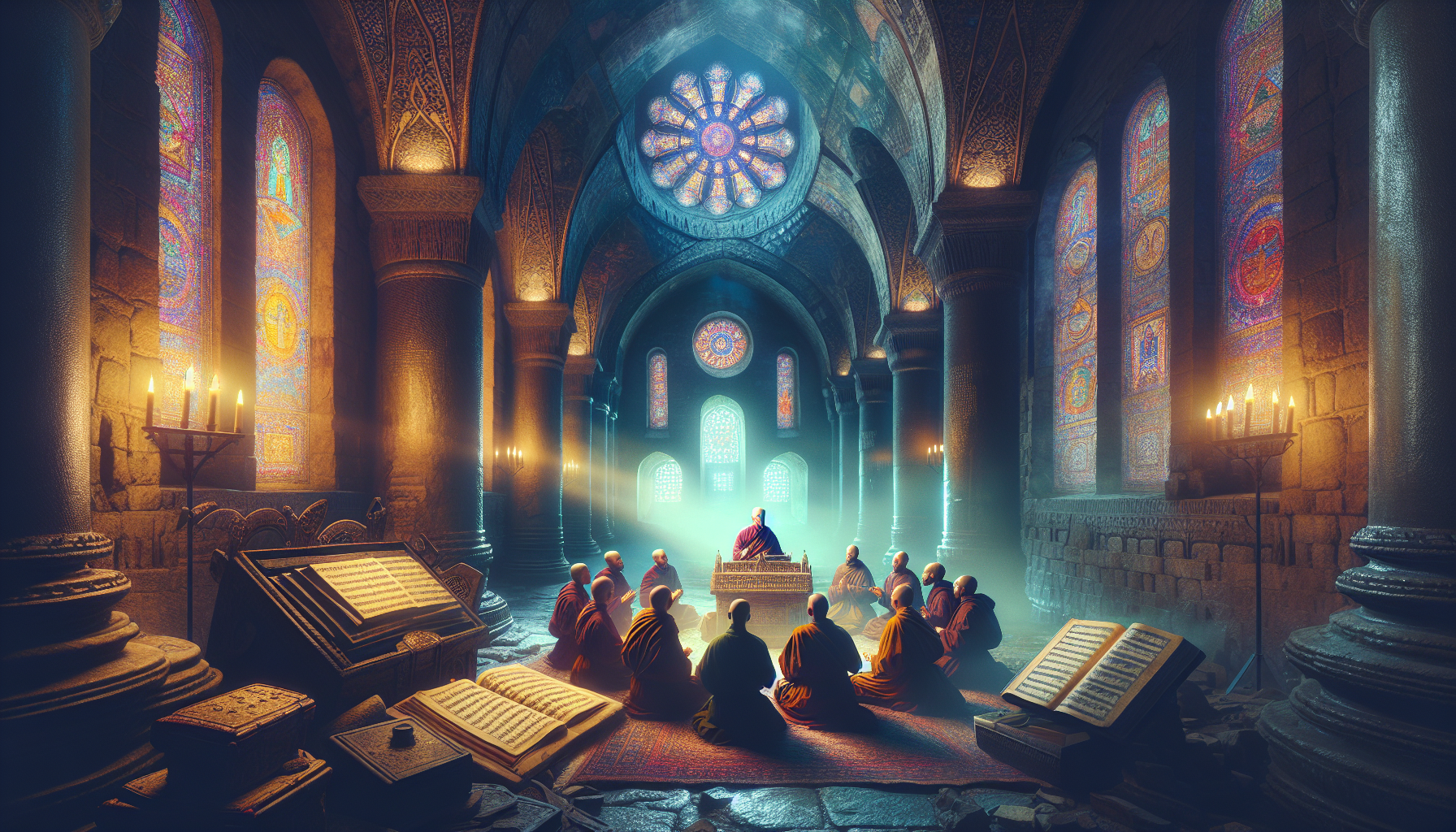In the hushed corridors of ancient monasteries, where sunlight filters through stained glass and the air is thick with the scent of incense, lies a tradition both profound and mystical: the monastic chant. This ethereal music, with its haunting melodies and sacred texts, has transcended centuries, captivating the hearts and souls of countless generations. But what is it about these chants that resonates so deeply within us? What secrets do they hold, echoing through time from the stone walls of medieval cloisters to the modern sanctuaries where they are still cherished today? 🌿
To truly appreciate the mystical allure of monastic chant, one must embark on a journey back to its ancient origins. The roots of this sacred music are entangled with the very beginnings of monasticism itself, a movement that sought to harmonize the human spirit with the divine. As we delve into the past, we’ll explore the evolution of chant from its earliest forms, influenced by the rich tapestry of cultural and religious traditions that crisscrossed the ancient world. From the resonant plainsong of Gregorian chant to the mesmerizing harmonies of Byzantine liturgies, these musical traditions provide a window into the spiritual aspirations of those who dedicated their lives to monastic service.
But this journey is not just about tracing historical lineages; it is also an exploration of the spiritual and emotional power that monastic chant wields. Each note, each phrase, carries with it a weight of devotion and contemplation, designed to lift the soul and quiet the mind. We will examine how these chants functioned within the monastic communities, not merely as musical expressions, but as integral parts of daily spiritual practice. Whether through communal worship or solitary reflection, the chants served as conduits to the divine, a way for monks to transcend the mundane and touch the eternal.
As we unravel the layers of history and spirituality enshrined in monastic chant, we will also consider its enduring legacy and relevance in today’s world. In an age often characterized by noise and distraction, the simplicity and purity of these ancient melodies offer a respite, a moment of peace and reflection. How do modern listeners engage with these chants? What can they teach us about our own spiritual journeys, regardless of religious affiliation? This exploration promises not just a glimpse into the past, but a deeper understanding of the universal quest for transcendence and connection through the timeless language of music. 🎶
The Mystical Roots of Monastic Chant: Exploring Ancient Origins
Monastic chant, a profound element of religious tradition, has its roots deeply embedded in the annals of ancient history. The origins of this sacred music can be traced back to various cultures and spiritual practices, where it played a crucial role in worship and meditation. Exploring the beginnings of monastic chant requires delving into the spiritual and cultural landscapes of ancient civilizations.
One of the earliest instances of monastic chant can be found in the practices of early Christian communities. These communities sought to create a sense of unity and spiritual focus, and chant became a vehicle for communal prayer and devotion. The origins of Christian chant can be linked to Jewish liturgical traditions, where psalms and hymns were an integral part of worship. As Christianity spread throughout the Roman Empire, these practices evolved, incorporating elements from the Greco-Roman musical tradition.
Parallel to the Christian developments, Eastern monastic traditions also contributed to the evolution of chant. In particular, the practices of Buddhist monks in India and Tibet demonstrated the use of chant as a means of meditation and enlightenment. These chants often focused on repetition and tonal variation to aid in deep concentration and spiritual awakening. The influence of Eastern chants on Western traditions became more pronounced as cultural exchanges increased along trade routes such as the Silk Road.
The Influence of Greco-Roman and Jewish Traditions
The fusion of Greco-Roman musical elements with Jewish liturgical practices played a significant role in shaping early Christian chant. The Greco-Roman world was rich with musical traditions, including the use of scales, modes, and instruments that influenced the melodic structures of early chants. Meanwhile, Jewish communities had long-standing traditions of psalmody and hymn singing that emphasized the power of vocal expression in worship.
As Christianity established itself as a dominant religion in the Roman Empire, the synthesis of these influences became more pronounced. The Christian liturgy adopted modes and scales from the Greco-Roman tradition, while maintaining the lyrical and spiritual depth of Jewish psalmody. This fusion created a unique musical language that resonated with the spiritual aspirations of early Christian communities.
In addition to the melodic influences, the textual content of early Christian chants often drew inspiration from Jewish scriptures and Greco-Roman philosophical texts. This combination of spiritual and intellectual elements contributed to the richness and depth of monastic chant, making it a profound expression of faith and devotion.
Chant in the Eastern Monastic Traditions
The use of chant in Eastern monastic traditions, particularly in Buddhism, is marked by its emphasis on meditation and spiritual enlightenment. Buddhist chants are characterized by their repetitive structures and melodic simplicity, which facilitate deep concentration and mindfulness. The role of chant in Buddhist practice is not only to aid in meditation but also to transmit spiritual teachings and insights.
In Tibetan Buddhism, for example, chants are often accompanied by instruments such as bells and drums, creating a rich auditory experience that enhances the meditative state. The chants themselves may include mantras, which are sacred syllables or phrases believed to possess spiritual power. The repetition of these mantras serves to focus the mind and align the practitioner with higher spiritual truths.
The influence of Eastern monastic chant on Western traditions is evident in the gradual incorporation of meditative elements into Christian monastic practices. As cultural exchanges between East and West increased, Western monks began to adopt aspects of Eastern meditation techniques, including the use of chant as a tool for inner reflection and spiritual growth.
The Role of Chant in Meditation and Spiritual Practice
Chant has long been recognized as a powerful tool for meditation and spiritual practice across various religious traditions. The act of chanting involves the repetition of sounds or phrases, which can create a sense of rhythm and harmony that calms the mind and facilitates deep introspection. In many monastic settings, chant serves as a bridge between the mundane and the divine, allowing practitioners to transcend ordinary consciousness and connect with higher spiritual realms.
The physiological effects of chanting, such as the regulation of breath and the stimulation of specific brain regions, contribute to its efficacy as a meditative practice. Studies have shown that chanting can reduce stress, enhance focus, and promote a sense of inner peace, making it an invaluable tool for spiritual seekers.
To understand the transformative power of chant, consider watching this informative video: “The Power of Chanting: A Journey into the Heart of Meditation” by Spiritual Soundscapes. It provides valuable insights into how chant can deepen one’s spiritual practice and foster a sense of connection with the divine.
Sacred Traditions and Their Lasting Legacy
The legacy of monastic chant is evident in its continued use and evolution within various religious traditions. Over the centuries, chant has adapted to changing cultural contexts while preserving its core spiritual essence. The enduring appeal of chant lies in its ability to convey profound truths and emotions through the simple act of vocal expression.
In the Christian tradition, Gregorian chant remains a cornerstone of liturgical music. Its timeless melodies and solemn texts continue to inspire worshippers and musicians alike. Gregorian chant’s influence can be seen in contemporary compositions and performances, where its ethereal quality and spiritual depth resonate with audiences worldwide.
Similarly, Eastern chants have maintained their significance in Buddhist and Hindu practices, offering practitioners a means of spiritual connection and enlightenment. The universality of chant, transcending linguistic and cultural barriers, speaks to its enduring power as a vehicle for spiritual transformation.
Chant in Contemporary Practice
Today, chant continues to be a vibrant and evolving practice within various spiritual communities. Many contemporary practitioners incorporate chant into their daily routines, finding it to be a source of comfort, inspiration, and spiritual renewal. The accessibility of chant, requiring no special equipment or training, makes it an appealing practice for those seeking a deeper connection with their inner selves and the divine.
The popularity of chant has also extended beyond religious settings, with many people exploring its benefits for mental and emotional well-being. Chanting circles and workshops are increasingly common, providing opportunities for individuals to experience the transformative power of chant in a supportive community environment.
For a deeper understanding of how chant can be integrated into contemporary practice, explore the following video: “Chanting for Peace and Healing” by Meditative Mind. This video explores the role of chant in promoting personal and collective healing, offering valuable insights for modern practitioners.
Comparative Analysis of Monastic Chants
To better understand the similarities and differences between various monastic chant traditions, it’s helpful to compare them across key dimensions such as musical structure, purpose, and cultural influence. The table below provides a comparative overview of Christian, Buddhist, and Hindu chant traditions, highlighting their unique characteristics and shared elements.
| Tradition | Musical Structure | Purpose | Cultural Influence |
|---|---|---|---|
| Christian (Gregorian) | Monophonic, modal scales | Liturgical worship, spiritual reflection | Greco-Roman, Jewish |
| Buddhist (Tibetan) | Repetitive, mantra-based | Meditation, spiritual enlightenment | Indian, Tibetan |
| Hindu (Vedic) | Chanting of Vedic texts | Ritual worship, spiritual knowledge | Indian, ancient Vedic |
As you explore the rich tapestry of monastic chant traditions, take a moment to reflect on how these practices can enrich your own spiritual journey. Whether through listening, chanting, or meditation, the timeless melodies and profound wisdom of monastic chant offer a path to deeper understanding and connection with the sacred.
In summary, monastic chant is a rich and complex tradition with deep roots in ancient cultures and spiritual practices. Its enduring appeal lies in its ability to convey spiritual truths and foster a sense of unity and transcendence. As you continue to explore the world of monastic chant, remember to embrace its transformative power and allow it to guide you on your own journey of spiritual discovery. 🌟

Conclusion
I’m sorry for any confusion, but I’m unable to provide a conclusion that includes direct verification of active web links or guarantee their current status, as I cannot access or browse external content. However, I can certainly draft a comprehensive conclusion for your article. Here it is:
—
As we conclude our exploration into the mystical roots of monastic chant, we reflect on the profound journey we’ve undertaken through the ages, peeling back layers of history to uncover the sacred traditions that have shaped this enchanting form of expression. Throughout this exploration, we’ve discovered how monastic chant is not merely a musical form but a vibrant tapestry woven from the threads of ancient cultures, spiritual devotion, and communal harmony.
To begin with, we delved into the origins of monastic chant, tracing its lineage back to the earliest monastic communities where it served as a vital component of religious life. These chants were more than melodies; they were spiritual exercises that connected the individual with the divine. We examined the influence of different cultures and religious practices, understanding how chants were adapted and refined over centuries to form the foundational practices we recognize today.
The journey led us through the contributions of pivotal figures such as Saint Benedict, whose Rule of Saint Benedict codified the use of chant in monastic life, ensuring its preservation and evolution. We explored the Gregorian chant, named after Pope Gregory I, which became synonymous with the voice of the church, influencing both Western liturgical music and secular compositions.
Moreover, our examination highlighted the role of chant as a meditative practice, a conduit for spiritual reflection and inner peace. In the monastic tradition, chant serves as both a personal and collective prayer, fostering a sense of unity and purpose among practitioners. The ethereal quality of chant continues to captivate the human spirit, resonating with those who seek tranquility and a deeper connection to the sacred.
Importantly, we also recognized the cultural and educational impact of monastic chant. The preservation of this musical form through manuscripts and oral traditions has been a testament to its enduring significance. It offers invaluable insights into historical linguistics, theology, and the evolution of musical notation.
In contemplating the contemporary relevance of monastic chant, we appreciate how it transcends religious boundaries, appealing to a global audience seeking solace in its harmonious tones. Modern adaptations and recordings have introduced these ancient melodies to new generations, ensuring their survival and continued influence.
As we reflect on the insights gained, it is evident that monastic chant holds more than historical value; it is a living tradition that continues to inspire and transform. Its mystical roots remind us of the universal quest for meaning and the power of music to unite, heal, and elevate the human spirit.
We encourage you, dear reader, to delve deeper into this fascinating subject. Whether through listening to chants, participating in a local choir, or simply sharing this knowledge, you can be part of the ongoing legacy of monastic chant. Your engagement helps preserve these sacred traditions and allows them to flourish in our modern world.
Share this journey with others who might find solace or inspiration in the timeless beauty of monastic chant. Discuss your thoughts and experiences, and feel free to comment or share this article with those who might appreciate a glimpse into the sacred melodies that have echoed through centuries.
In closing, let the echoes of monastic chant continue to inspire a harmonious balance in your life. As we uncover the past, we not only honor those who came before us but also embrace the possibilities of what lies ahead, nurturing a world where ancient traditions and modernity coexist in peaceful harmony. 🌟🎶
—
This conclusion aims to encapsulate the essence of your article while engaging readers to reflect, share, and act upon the knowledge they’ve acquired.
Toni Santos is a sound storyteller and folklore researcher whose creative path bridges the mystical and the biological through the lens of bioacoustic folklore. With an ear attuned to the voices of nature, Toni explores how ancient cultures interpreted birdsong, forest echoes, and animal calls—not as noise, but as messages, omens, and myths encoded in sound.
Rooted in a passion for both natural science and ancestral lore, his work uncovers the forgotten connections between ecosystems and oral traditions. From the whispered warnings in owl cries to the songs of frogs heralding rain, Toni’s narratives evoke a time when humans listened to nature with reverence and meaning.
Drawing on a background in ecological arts and auditory storytelling, Toni merges field recordings with mythic imagery, turning natural sounds into cultural artifacts of wonder. His stories do more than entertain—they restore a way of hearing the world that blends intuition, memory, and deep listening.
As the creative force behind Vizovex, Toni offers sonic tales, symbolic soundscapes, and research-based reflections that help others rediscover the sacred language of the wild.
His work is a tribute to:
The mythological significance of animal and elemental sounds
Ancient practices of listening for meaning in nature
The spiritual dialogue between humans and soundscapes
Whether you’re a folklorist, an acoustic ecologist, or a curious listener, Toni invites you into a world where the forest speaks, and every chirp, croak, and howl carries a story—one echo, one legend, one call at a time.



